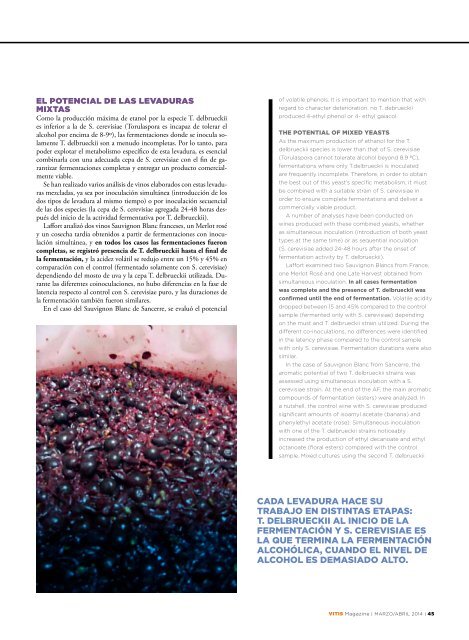rev_57
rev_57
rev_57
You also want an ePaper? Increase the reach of your titles
YUMPU automatically turns print PDFs into web optimized ePapers that Google loves.
EL POTENCIAL DE LAS LEVADURAS<br />
MIXTAS<br />
Como la producción máxima de etanol por la especie T. delbrueckii<br />
es inferior a la de S. ce<strong>rev</strong>isiae (Torulaspora es incapaz de tolerar el<br />
alcohol por encima de 8-9º), las fermentaciones donde se inocula solamente<br />
T. delbrueckii son a menudo incompletas. Por lo tanto, para<br />
poder explotar el metabolismo específico de esta levadura, es esencial<br />
combinarla con una adecuada cepa de S. ce<strong>rev</strong>isiae con el fin de garantizar<br />
fermentaciones completas y entregar un producto comercialmente<br />
viable.<br />
Se han realizado varios análisis de vinos elaborados con estas levaduras<br />
mezcladas, ya sea por inoculación simultánea (introducción de los<br />
dos tipos de levadura al mismo tiempo) o por inoculación secuencial<br />
de las dos especies (la cepa de S. ce<strong>rev</strong>isiae agregada 24-48 horas después<br />
del inicio de la actividad fermentativa por T. delbrueckii).<br />
Laffort analizó dos vinos Sauvignon Blanc franceses, un Merlot rosé<br />
y un cosecha tardía obtenidos a partir de fermentaciones con inoculación<br />
simultánea, y en todos los casos las fermentaciones fueron<br />
completas, se registró presencia de T. delbrueckii hasta el final de<br />
la fermentación, y la acidez volátil se redujo entre un 15% y 45% en<br />
comparación con el control (fermentado solamente con S. ce<strong>rev</strong>isiae)<br />
dependiendo del mosto de uva y la cepa T. delbrueckii utilizada. Durante<br />
las diferentes coinoculaciones, no hubo diferencias en la fase de<br />
latencia respecto al control con S. ce<strong>rev</strong>isiae puro, y las duraciones de<br />
la fermentación también fueron similares.<br />
En el caso del Sauvignon Blanc de Sancerre, se evaluó el potencial<br />
of volatile phenols. It is important to mention that with<br />
regard to character deterioration, no T. debrueckii<br />
produced 4-ethyl phenol or 4- ethyl gaiacol.<br />
THE POTENTIAL OF MIXED YEASTS<br />
As the maximum production of ethanol for the T.<br />
delbrueckii species is lower than that of S. ce<strong>rev</strong>isiae<br />
(Torulaspora cannot tolerate alcohol beyond 8.9 ºC),<br />
fermentations where only T.delbrueckii is inoculated<br />
are frequently incomplete. Therefore, in order to obtain<br />
the best out of this yeast’s specific metabolism, it must<br />
be combined with a suitable strain of S. ce<strong>rev</strong>isiae in<br />
order to ensure complete fermentations and deliver a<br />
commercially viable product.<br />
A number of analyses have been conducted on<br />
wines produced with these combined yeasts, whether<br />
as simultaneous inoculation (introduction of both yeast<br />
types at the same time) or as sequential inoculation<br />
(S. ce<strong>rev</strong>isiae added 24-48 hours after the onset of<br />
fermentation activity by T. delbrueckii).<br />
Laffort examined two Sauvignon Blancs from France,<br />
one Merlot Rosé and one Late Harvest obtained from<br />
simultaneous inoculation. In all cases fermentation<br />
was complete and the presence of T. delbrueckii was<br />
confirmed until the end of fermentation. Volatile acidity<br />
dropped between 15 and 45% compared to the control<br />
sample (fermented only with S. ce<strong>rev</strong>isiae) depending<br />
on the must and T. delbrueckii strain utilized. During the<br />
different co-inoculations, no differences were identified<br />
in the latency phase compared to the control sample<br />
with only S. ce<strong>rev</strong>isiae. Fermentation durations were also<br />
similar.<br />
In the case of Sauvignon Blanc from Sancerre, the<br />
aromatic potential of two T. delbrueckii strains was<br />
assessed using simultaneous inoculation with a S.<br />
ce<strong>rev</strong>isiae strain. At the end of the AF, the main aromatic<br />
compounds of fermentation (esters) were analyzed. In<br />
a nutshell, the control wine with S. ce<strong>rev</strong>isiae produced<br />
significant amounts of isoamyl acetate (banana) and<br />
phenylethyl acetate (rose). Simultaneous inoculation<br />
with one of the T. delbrueckii strains noticeably<br />
increased the production of ethyl decanoate and ethyl<br />
octanoate (floral esters) compared with the control<br />
sample. Mixed cultures using the second T. delbrueckii<br />
Cada levadura hace su<br />
trabajo en distintas etapas:<br />
T. delbrueckii al inicio de la<br />
fermentación y S. ce<strong>rev</strong>isiae es<br />
la que termina la Fermentación<br />
alcohólica, cuando el nivel de<br />
alcohol es demasiado alto.<br />
Vitis Magazine l marzo/abril 2014 l 45


